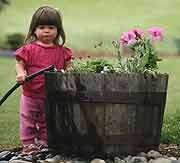What looks like play may really be a science experiment

(HealthDay)—You may think your toddler is just playing in the sand box, but she may really be conducting a sophisticated scientific experiment and learning something new every time she pours out another scoop of sand, new research suggests.
"Children have the same brains we do. Everyone can learn from data and know if a hypothesis is good or not," explained Alison Gopnik, a professor of psychology at the University of California, Berkeley. "Even babies and very young children learn about the world in many of the ways that scientists do. Only when children do experiments, we say 'they're getting into everything!'"
Gopnik is the author of a report in the Sept. 28 issue of Science that reviews previous studies on how children learn.
She said that in the past people thought preschoolers were irrational and illogical. However, during the 1980s and 1990s, researchers realized that young children actually had coherent, structured thoughts and could make causal inferences about the world around them. They might not yet be able to verbalize all of those thoughts and inferences, but they're learning from them, said Gopnik.
One experiment reviewed by Gopnik illustrated how even babies can act like mini-scientists and use a probability model. In this experiment, a researcher showed babies a box full of red and white balls. Then the researcher closed her eyes and randomly removed some balls from the box and placed them in another small bin. If the sample was truly random, the distribution of the balls should be close to that of the original container. For example if the original container held mostly red balls, the smaller bin should also have mostly red balls.
But, sometimes the researchers switched the samples, giving the babies an unexpected result. When the sample of balls didn't match the expected distribution of balls, the babies stared at the non-matching sample longer.
Another experiment, this one conducted by Gopnik and her colleagues, asked 2-, 3- and 4-year-olds to make a machine play music or to stop the music. To do so, they needed to place a block on the machine. But, not all of the blocks would turn on the machine.
The preschoolers were shown that block A alone turned the machine on, block B did not turn the machine on, but A and B together turned the machine on. She said the children were able to figure out the correct patterns to either make the machine go or stop. And, that was true even for the youngest children in the experiment, who were only 24 months old.
Gopnik said that children seem to learn best when they can "explore and discover the world through spontaneous play," and that some of the current pressure to make preschools more academic might end up being counterproductive.
"Explicit teaching can also narrow the range of hypotheses that children are willing to consider. Activities, such as encouraging play, presenting anomalies and asking for explanations prompt scientific thinking more effectively than direct instruction," Gopnik wrote.
One expert praised the elegance of the review.
"This is an interesting, but simple idea, presented in a rather sophisticated way," said Dr. Andrew Adesman, chief of developmental and behavioral pediatrics at the Steven and Alexandra Cohen Children's Medical Center of New York in New Hyde Park.
Adesman said that he wasn't, however, particularly concerned about changes in preschool education. He noted that most preschool programs are usually only a couple of hours a day, which leaves children plenty of time to engage in spontaneous play. Plus, he said, "kids can learn from many difference experiences and exposures. They can learn in many different ways."
So, while they may be little scientists for a few hours of the day, they can also likely learn the alphabet in a more rote way, he suggested.
But parents can nurture their child's natural inquisitiveness by providing spontaneous play opportunities whenever possible, he added.
Gopnik echoed that sentiment. "Look at what your children are interested in. They can learn a lot about the world by putting mixing bowls together, or playing with sand, or through pretend play," she said. "Join in with them when you can. And, answer children's questions and provide explanations, but also ask children why they think something happened. That's a good way to trigger their scientific minds."
More information: Read more about how children learn through play from the Nemours Foundation.
Paper: : "Scientific Thinking in Young Children: Theoretical Advances, Empirical Research, and Policy Implications," by A. Gopnik, Science, 2012.
Copyright © 2012 HealthDay. All rights reserved.














